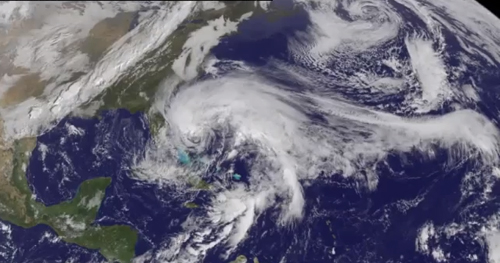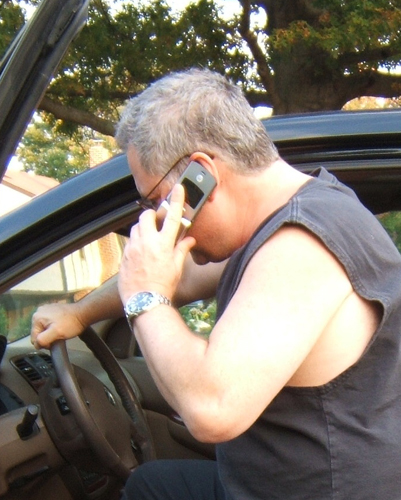
Above: The path of Hurricane Sandy is captured by NASA's GOES-13 weather observation satellite. The weather effects of this hurricane disaster impacted cities as far west as Chicago.
Preppers in New England had their chance to put home disaster plans to use in the wake of Hurricane Sandy this week. While Living Ready spends a good deal of time on preparing ahead of disasters, it's no less important to know what to do after the weather settles down.
Here are tips for what to do after a hurricane disaster or other devastating natural event.
Get to a Smart Phone

Many people carry smart phones that enable access to the Internet. In 2012, this is the post-hurricane disaster lifeline. Standard mobile phones are also helpful, but it's the Internet access that's just as important as the ability to make calls. The Internet offers weather updates, condition reports and quick communication channels.
If you don't have an operating phone, find someone who does. If this isn't possible, get to wherever a large group of people has gathered. You'll need information just as much as you need food, water and shelter.
Note: In some cases, mobile technology won't be available anywhere. For more on what to do then, click here to read The Day the Cell Phones Died.
Save Battery Power with Social Media
If you don't have the ability to charge your mobile phone, use it sparingly. This is where having a smart phone with Internet access becomes essential.
Using social media, you're able to stay in contact with quick messages that don't require monitoring. You can make a post on your Facebook page, turn off the phone and check the post for replies later. In seconds, you'll have reached more people than you could in several minutes of calling. You also won't waste power listening to voice messages.
Again, if communication by phone becomes impossible after a hurricane disaster, seek out places people have gathered. This keeps you “in the loop” and makes coordinating your next moves clearer.
How to Find Family Members
Hopefully, you already have a family communication plan in place. If you don't anticipate making one, go right now to SafeandWell.org and bookmark it in your browser (better yet, in your smart phone's browser). Tell your family and friends to do the same as part of your post-disaster communication plan.
This website is operated by the Red Cross specifically for letting family and friends know you're OK post-hurricane disaster. Survivors can list themselves as “safe and well.” Others can browse for your listing.
The real benefit of this site is that it's used almost universally post-disaster. Even if you didn't set up a family communication plan pre-disaster, it's the go-to website for finding loved ones. Relief workers and other officials may encourage survivors to list themselves there.
Of course, the site only works if you're able to access it. For finding those not “safe and well,” you'll need to contact area hospitals.
Calling people using a mobile phone is instinctual, but be careful about using battery power.
Returning Home
Just because officials allow residents to return to their homes after a hurricane disaster doesn't mean caution can be thrown to the wind. Watch for down power lines, unusual smells (such as gas), shattered glass underfoot and dead ends on the roads. It's not that you won't do these things anyway, but putting your guard down is the first step to getting hurt.
Finding your home in ruins is a devastating experience. The variables that situation presents won't be covered here, but there are steps to take if your home is no longer liveable.
The Federal Emergency Management Agency (FEMA) runs a shelter locator that works via text message. Text the word SHELTER, followed by your ZIP code, to 43362. (That spells out 4FEMA.) As an example, you'd text SHELTER 54990. Information will be texted to your phone with information about the nearest shelters.
You can also call 1-800-RED-CROSS for shelter information.
If you're in need of long-term shelter, apply for assistance at FEMA.gov or head here for rental information.
Inspecting Damage
 After contacting your insurance agent, start photographing the damage caused by the hurricane disaster. This can be done on many mobile phones. The sooner the better. You'll need proof to back up your damage claim.
After contacting your insurance agent, start photographing the damage caused by the hurricane disaster. This can be done on many mobile phones. The sooner the better. You'll need proof to back up your damage claim.
It's important to do this before cleaning up. Depending on the terms of your policy, there may be a difference between “acts of God” (such as a hurricane) and damage created by human hands post-disaster. This could include your own clean-up efforts, looting or some other intentional act.
If you're inspecting damage in low-light conditions, use a battery-powered flashlight. Turn it on before entering a building, just in case there are flammable gases inside that you haven't yet detected. Don't use candles.
Always wear protective clothing and move about with caution. A good idea is to use a walking stick. Test the area in front of you before walking into it. Remember that structural damage in buildings can weaken floors.
Medicine
There isn't a fool-proof solution for those who need refills of prescription drugs. Following the hurricane disasters of 2005 in the southern United States, the website ICERx.org (In Case of Emergency Prescriptions) was founded by a number of medical organizations. The aim was to create a comprehensive prescription database pharmacies could pull from to fill scripts post-disaster.
However, this initiative wasn't sanctioned by the federal government and raised privacy concerns. This writer cannot determine whether ICERx.org is still operational. Its website doesn't appear to be functioning and its phone number does not connect.
Regardless of whether such a program exists, the best way to refill prescriptions is to have your script number on-hand. This code, quickly found on pharmacy-issued container labeling, allows pharmacists to easily find and fill your prescription. Not having this information means filling up could take much longer.
In some cases, pharmacies may issue emergency prescriptions regardless of whether your information can be located. Don't count on it. Have your prescription number with you.
Food & Water
There are many avenues food and water may be made available to you post-disaster. Hopefully, you already have a survival kit that takes care of these needs. Relief agencies may also be distributing these critical resources.
The thing to watch for is tainted food and water. If refrigerated foods reach more than 40 degrees Fahrenheit, throw them away. That usually means two hours for meats in the fridge and four hours for most other items. This chart from FoodSafety.gov spells out exactly when food in the fridge is no longer safe to eat.
Water lines can become contaminated post-hurricane disaster. Don't drink out of the tap until you are 100% positive it is potable. If you have to, boil water.
Your Turn: What Post-Hurricane Disaster Tips Can You Offer?
Although they could apply to many natural events, these tips are only a sampling of what to do after a hurricane disaster. What post-hurricane disaster tips can you share? Post them in the comments below or join this discussion on GunForums.com.
From rolling blackouts to hurricanes, floods to tornadoes, power can go out at a moment's notice. If the grid fails, the PowerPot will keep you charging! The PowerPot thermoelectric generator converts any heat source directly into power that charges your USB handheld devices. Get Yours Now


![Best Concealed Carry Guns In 2025 [Field Tested] Wilson Combat EDC X9S 1](https://gundigest.com/wp-content/uploads/Wilson-Combat-EDC-X9S-1-324x160.jpg)


![Best 9mm Carbine: Affordable PCCs [Tested] Ruger Carbine Shooting](https://gundigest.com/wp-content/uploads/Ruger-Carbine-Shooting-100x70.jpg)
![Best AR-15: Top Options Available Today [Field Tested] Harrington and Richardson PSA XM177E2 feature](https://gundigest.com/wp-content/uploads/Harrington-and-Richardson-PSA-XM177E2-feature-100x70.jpg)
